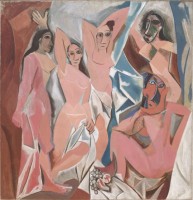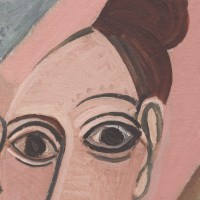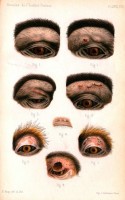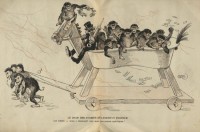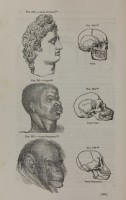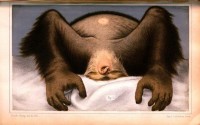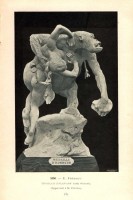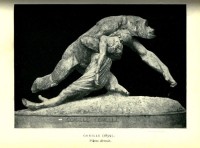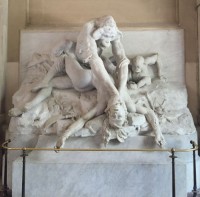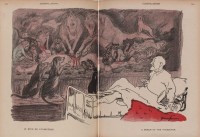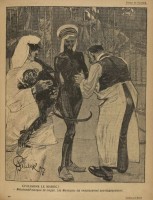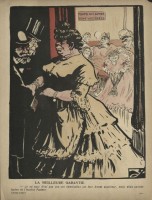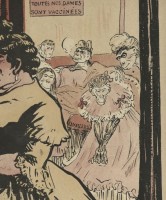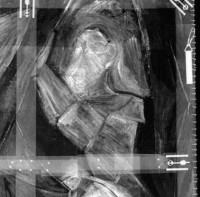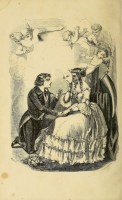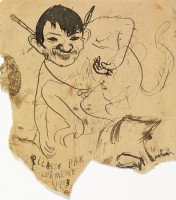The browser will either open the file, download it, or display a dialog.
On the left eyebrow of the central figure in Picasso’s Les Demoiselles d’Avignon, an arabesque of impasto marks interrupts the deliberate, basket-weave strokes of pale ochre constituting her forehead (figs. 1, 2). These marks, along with the faces of the two centermost women, are overlooked in visual analyses of the painting, perhaps because they lose out in avant-garde strangeness to the visages of the other three figures or the painting’s much-vaunted collapsing of pictorial space. Examined closely, however, these diminutive marks emerge as palimpsests. Rising from the surface of the Demoiselles’ painted skin, these bumps can be read as references to the scarification practiced by many indigenous cultures in Africa and Oceania, which would have been familiar to European audiences through ethnographies and world’s fairs. As anthropologist Enid Schildkrout posits, the frequent identification of indigenous bodies as both scarified and exotic led to a conflation of body modifications with nonwhite skin in the late nineteenth century.[1] Scarification also appears on some African masks, which anthropologists have largely described as a “second skin” that could likewise be decorated and modified.[2] Given Picasso’s hyperbolically well-documented interest in African and Oceanic art objects and the marks’ visual likeness to modification practices, this seems like a plausible point of influence.
Yet there were other modes of scarification visible to European publics in the years surrounding 1900. Physicians regularly used scarification to treat a myriad of skin diseases. Describing the therapeutic process of scarification in 1904, dermatologist Émile Leredde advises physicians to hold the scarifier between the fingers as one would a pen, stretch the afflicted skin taut between the thumb and index finger, and inscribe the skin with “fine, superficial incisions in the epidermis and a more or less deep portion of the dermis,” moving the scarifier over the skin “like a draughtsman makes hatch marks to darken a drawing.”[3] As the skin healed, it would harden to create stiff scar tissue. Leredde’s description bears a striking resemblance to Richard Shiff’s analysis of modernist painting and touch, where impastoed taches, or touches, can be understood as simultaneously indexing the action undertaken by the painter to leave a mark, the sensation experienced by the painter making said mark, and the mark itself.[4] Picasso and Leredde both deploy a precise and deliberate facture. Filtered through the lens of Shiff’s analysis, their affinity allows us to draw direct connections between physician and artist, skin and canvas, and scar tissue and pigment. The process of sclerosis instigated by the scarification of the skin also morphologically mirrors the application of oil paint to its support. The gesture becomes all the more literal in the case of primed canvases like the one used for the Demoiselles, to which Picasso applied rabbit-skin sizing in order to decrease its absorbency.[5] The primed canvas, like the skin, begins as a supple, semipermeable surface; oil paint laid on top, particularly in thick layers, dries and stiffens slowly over the course of days, months, or years.
Physicians also used scarification to inoculate live subjects with pathogens in experimental medicine. Between 1903 and 1906, Institut Pasteur researchers Émile Roux and Élie Metchnikoff[6] conducted a series of studies methodologically relying on the technique known as the “Experimental Studies on Syphilis.”[7] The scientists framed the trials as an effort to re-arm France against what they perceived as the deep, degenerative danger posed by syphilis.[8] To sidestep the ethical quandaries that rendered vital experimentation on humans immoral, Roux and Metchnikoff proposed the inoculation of monkeys, the animals closest to the human species on the evolutionary ladder. They claimed that by introducing and maintaining syphilitic infection in anthropoid apes, they could study syphilis’s long-term effects, come closer to unearthing its causal agent, and ultimately locate a cure.[9] Writing in the Annales de l’Institut Pasteur in 1904, Roux and Metchnikoff describe their scarification techniques as follows: “The inoculation . . . consisted of a great number of small, superficial scarification marks, placed on the arches of the eyebrows, the eyelids, and on the genital organs.”[10] Like Leredde, Roux and Metchnikoff prescribe short, quick, and superficial strokes on the skin’s surface, emphasizing the importance of a delicate yet deliberate hand for the successful inoculation of their subjects. The scientists supplied Planche V (Plate V) to illustrate the inoculation sites and resulting syphilitic symptoms, whose precise locations are best preserved in the sixth figure within the plate (fig. 3). Three darkened sores appear as small perforations from which rose-colored skin emerges, indicating infection. The sores gently curve around the arch of the monkey’s brow, uncannily mirroring the dexterously applied arch of impastoed bumps tracing the eyebrow of the central demoiselle.
In this article, I take up these final threads of the marks’ layered associations to argue for a significant relationship between Picasso’s Les Demoiselles d’Avignon and Roux and Metchnikoff’s “Experimental Studies.” I position the visual resemblance between Plate V and Picasso’s central figure and the analogies between artist and researcher, paintbrush and scarifier, and canvas and skin as jumping off points from which I argue for deep formal, material, morphological, and philosophical connections between what has been regarded as Picasso’s most canonical contribution to the history of art and these seemingly esoteric experiments.[11] I locate a series of caricatures lampooning the “Experimental Studies” published in the illustrated anarchist weekly L’Assiette au beurre at the nexus of this connection. In so doing, my aim is to dissolve the disciplinary divides that typically segregate the histories of these objects by revealing the unexpectedly broad reach of the “Experimental Studies’” hypotheses, stakes, and claims, which I trace far beyond the field of medicine. As I demonstrate, resonances of the “Experimental Studies,” particularly Roux and Metchnikoff’s articulations of human and animal bodies, radiate out through political and artistic channels to the anarchist circles that produced L’Assiette au beurre and, through this network, into the sphere of avant-garde art.
I begin with a thorough analysis of L’Assiette au beurre’s pictorial responses to the “Experimental Studies,” which were published between 1905 and 1907. While the studies were not particularly well known, the magazine’s illustrators explicitly invoke Roux and Metchnikoff’s trials multiple times over the course of two years; they represent these monkeys as prostitutes detained in Parisian brothels or as Moroccans enduring the brutality of colonial medicine, alternately anthropomorphizing apes and zoomorphizing these human subjects of the French empire. Recuperating these quintessential examples of popular culture, I employ a close reading of the images to point to the way bodies—monkey, female, North African—are pictorially stripped, blended, and interrogated. I aim to unpack L’Assiette au beurre’s pointed interest in the studies and the stakes of visually conflating these bodies at a moment when discourses of inheritance framed syphilis as a veritable threat to the nation and identified female and African bodies as not only biologically inferior, but also as reservoirs of disease. To contextualize this pictorial hybridity, I consider additional sources of simian imagery that circulated widely at the turn of the century: Emmanuel Frémiet’s sculptures depicting human-ape conflicts. Through these sculptures, I articulate the anthropoid ape’s shifting significations in the later nineteenth century, fleshing out their material relationship to experimental medicine and burgeoning scientific discourses of race and evolution alongside tensions surrounding their relative proximity to the human. Returning to L’Assiette au beurre’s caricatures, I contend that the weekly’s broader critiques of French colonialism, experimental medicine, and white, bourgeois identity motivate their representations of Roux and Metchnikoff’s monkeys. I situate this critique and the intertwined concerns about syphilis, colonialism, and prostitution it discloses as a substantial link to the Demoiselles. In so doing, I identify these chromolithographs as unexpected filters of vanguard medical studies that illuminate the shared logics structuring research in experimental medicine, colonial medicine, venereology, and public health. The invocation of these shared logics by both L’Assiette au beurre and Picasso evince the ways scientific and medical discourses of raced, gendered, diseased, and animal bodies permeated multiple spheres of knowledge and visual culture production.
By drawing an association between the Demoiselles and the “Experimental Studies,” my intention is not to raise the old specter of Picasso’s potential syphilitic infection.[12] Nor do I want to evoke the equation of faces ravaged by syphilis and the supposedly deformed faces of the masked demoiselles drawn by some twentieth-century art historians and most notably problematized by Anna Chave in her seminal article on the painting.[13] Furthermore, while a great deal of scholarship on the Demoiselles eschews these readings, the majority of the writing on the painting continues to rely on biographical or psychoanalytical frameworks.[14] This mode of reading the painting has become so ingrained in scholarly thought that the Demoiselles and the visit to the Trocadéro that it presupposes has come to serve as shorthand for a—or even the—primal scene of colonialist desire and disavowal.[15] Scholarship buttressed by biography is certainly valuable and has contributed significantly to our understanding of the Demoiselles, and the arguments detailed in this essay can be interpreted as strengthening some of those claims. However, I contend that the evidence considered in this article tells a rich story apart from biography and psychoanalytic interpretations, and that the nagging feeling that one cannot discuss the Demoiselles without becoming ensnared in these debates has stifled our ability to think and write about this painting. Therefore, in this article I aim to firmly re-root the Demoiselles in its sociohistorical context and the conditions surrounding its production, especially the intersection of visual art and medicine. This includes juxtaposing it with visual culture produced in the first decade of the twentieth century outside the sphere of modernist painting, here medical images and the caricatures of the L’Assiette au beurre, in a manner that underscores both historical and formal linkages among these objects.
The Bite of Laocoön’s Serpent
Before undertaking a sustained visual analysis of L’Assiette au beurre’s caricatures, I first want to briefly sketch the status of syphilis and its study around 1900. At this time, physicians had neither developed a reliable cure for the disease nor had they identified the pathogen that caused infection. As the symptoms of syphilis manifested on the skin’s surface, study of the disease fell between the related disciplines of dermatology and venereology, specialties often taken up together in the late nineteenth century.[16] Yet, compared with other dermatological conditions, the typical progression of syphilitic infection—three stages of highly visible rashes interrupted by somewhat unpredictable periods of remission—resulted in a marked degree of visual, and thus diagnostic and therapeutic, uncertainty. Syphilographer Philippe Ricord made significant strides in research at mid-century, most notably identifying the three stages described above, but progress stalled in the 1880s and ’90s.[17] This frustration extended to physicians’ efforts to curb what they understood as an increasingly dire public health crisis; between 1880 and 1900, French government officials ignored scores of proposed public hygiene measures and reforms.[18] These sentiments reached their apex in 1901, when the eminent syphilographer Alfred Fournier founded the Société Française de Prophylaxie Sanitaire et Morale (SFPSM). Fournier framed the SFPSM as a space where physicians could unite in their efforts to study, treat, and prevent syphilis, with or without government aid. Roux and Metchnikoff became members in 1901 and 1905, respectively. It was in this climate of exasperation that the scientists began their trials.
L’Assiette au beurre published its first critique of the Institut Pasteur’s experiments in a March 1905 issue (fig. 4). By this time, the magazine had been in print for several years and had emerged as a leading satirical organ of avant-guerre anarchism. Art historian Patricia Leighten describes the journal as “a crossroads for anarchism and modernism” that served as a crucible for the development of modernist aesthetics—although its role in this capacity remains under-recognized.[19] As Leighten argues, L’Assiette au beurre artists used visual “strategies of inversion” to both sharpen their critique and evade censorship laws.[20] These inversions, however, did not remain isolated to the weekly, but rather filtered into vanguard painting, where academic traditions were similarly upended.[21] Picasso’s social circles heavily overlapped with those of the weekly, and Leighten’s evaluation suggests that the kind of scathing humor at home in the pages of L’Assiette au beurre fueled both artistic and political life in the Bateau-Lavoir.[22] Scholars have suggested that Picasso submitted drawings to the magazine and that its publishers may have even solicited Picasso’s services for the illustration of a full issue, although none of his work has yet been identified in issues of the magazine.[23] Regardless, Picasso’s politics, Parisian contacts, and artistic practice connected him to the magazine in substantial ways, particularly after 1904 when André Salmon became involved with the weekly.[24]
The 1905 print appeared in an issue titled Carnival and illustrated by César Giris. Among the floats on parade in this fictional celebration, Giris includes the “degenerate syphilitics of the Institut Pasteur.”[25] Four bipedal, anthropoid apes pull a modern incarnation of the Trojan horse along the parade route. Giris’s decision to evoke this particular classical myth, understood as the denouement in accounts of the Trojan War, gains significance when considered alongside fin-de-siècle conceptions of syphilitic infection. Syphilis’s ability to imitate other illnesses—earning it the moniker “the great imitator”—allowed it to infiltrate the boundaries of the body undetected.[26] This invisible corruption parallels the Greeks’ discreet penetration of Troy’s defended walls to end the decade-long military conflict. Contemporary medical literature buttresses this connection. Syphilitic infection was sometimes referred to as the “embrace” of Laocoön’s serpent.[27] Here, Laocoön references the Trojan priest who attempted to warn his fellow citizens about the threat posed by the Greeks’ gift, and who was killed by two venomous serpents sent down by the gods. Notably, it is the serpent’s “embrace,” a term that at once signifies kiss and bite, which causes infection.
A sunglass-sporting Metchnikoff sits at the float’s helm. The physician’s eyewear implies that he, too, may be syphilitic and suffering the effects of the disease’s third stage, when both blindness and cognitive impairment became potential symptoms. The doctor also clutches a comically oversized clyster, a syringe used to administer enemas, to his chest. A mainstay in French satirical illustration for centuries, the clyster was often included to undermine the intelligence and respectability of those pictured undergoing the treatment.[28] Here, it compounds the critique of Metchnikoff’s mental health while also invoking the apparatus’s use in the treatment of syphilis through the second half of the nineteenth century and the syringe-based treatments that would replace it.[29] Its comically oversized tip and implied penetration visually pun on the scientists’ repeated experimental inoculations of their simian subjects. Nine additional apes look out and wave to the crowd from inside the belly of the horse. Like the Greeks, they have become deceptive agents of infiltration, here threatening to breach bodily defenses. They release innumerable slips of paper bearing common given names for women into the crowd—“Lucie, Lulu, Virginie, Edwige.”[30] The lack of surnames suggests that they might refer to the names the apes received in the laboratory. Edwige was, in fact, the name given to one of Roux and Metchnikoff’s subjects; she first expressed symptoms of syphilis in August of 1903 and died by October of that same year.[31] Yet the flurry of names also recalls prostitutes’ common practice of taking on a new given name, sans surname, to use at work. Giris’s caption bolsters this reading: “Monkeys—thanks to Metchnikoff, we, too, are syphilitic!”[32] Here, “too” invokes those who were already syphilitic in the public imagination: prostitutes. Crowning the classical allusion suggested by the Trojan horse, a final ape places an oversized laurel wreath—an ancient symbol of physical and intellectual victory—above the scientist’s head.
Notably, Giris was not the first to pictorially link degeneration with animality, references to the classical body, and Greco-Roman culture. Their juxtaposition finds precedent in the scientific racism that pervaded nineteenth-century discourses surrounding civilization and the perceived evolutionary hierarchy of the races. This hierarchy, largely based on purportedly measured and observed differences among the races in skull shape and size, was frequently communicated through visual representations. In these diagrams, monkeys famously occupy the lowest position while civilization reaches its apex with the classical Greek male, whose representation was frequently modeled on ancient sculpture.[33] Josiah Nott’s illustration of the comparative anatomy of the races (fig. 5) epitomizes this visual convention; the diagram’s emphatic verticality pictorially doubles down on its message of racial and animal stratification. Art historian Anthea Callen clarifies the links drawn between simian skull shapes and class by both scientists and artists in fin-de-siècle Paris. Callen argues that the visual signs of female atavism identified by physicians and naturalists filtered into artistic representations of lower-class women, particularly prostitutes, in the form of simian and animal qualities in the face: an acute facial angle; thick, dark hair; or a mouth that closely resembles a muzzle.[34] David Lomas draws attention to this phenomenon in relation to the Demoiselles in particular, citing descriptions of atavism in prostitutes in physical anthropology as potentially contributing to Picasso’s formal decisions, although Lomas does not link these descriptions to specific formal elements on the canvas.[35] Giris’s caricature pushes this relationship to its limit, such that these syphilitics, these prostitutes, are monkeys.
Significantly, the illustrations Roux and Metchnikoff paired with their research reports evidence of the trickling of Beaux-Arts pictorial conventions back into scientific publications. Accompanying their first report, they include a colored photograph illustrating a chancre on a monkey’s vulva made by Félix Méheux (fig. 6). Méheux does not closely crop his photograph to focus on the details of the lesion itself, as was typical in dermatological image making at the time. Rather, he pans out to reveal a wrinkled white bed sheet, the ape’s spread thighs, and her furry, rounded belly. Méheux’s framing draws comparisons to overtly erotic imagery and paintings of the modern nude, such as Courbet’s 1866 L’Origine du monde. He also evokes the intimacy and exploitation of the gynecological exams undergone by prostitutes—and simian Institut Pasteur research subjects—at regular intervals. As Callen and others have argued, it is well known that these examinations were largely ineffective, as the prostitutes’ customers were not also inspected. Rather, these medical examinations served the burgeoning disciplines of public hygiene, obstetrics, gynecology, and venereology, allowing the professionals in these fields to demonstrate the significance of their work while simultaneously providing them with practical experience and a large population of clinical material from which to draw conclusions and publish research.[36] Through Giris’s pictorial conflation of human and ape, prostitute and laboratory specimen, he presses his viewer to critically consider the differences between the two in the eyes of medical researchers and the general public alike.
Animal Uprisings
Emmanuel Frémiet’s 1887 plaster sculptural group, Gorille enlevant une femme (Gorilla Carrying Off a Woman), similarly challenged the public to scrutinize what differentiated human from ape, if in a more threatening manner (fig. 7). In this group, which won the Medal of Honor in the 1887 Salon and was later exhibited at the Paris Universal Expositions of 1889 and of 1900, Frémiet depicts a life-size gorilla baring its teeth and clutching a struggling woman to its breast.[37] While the animalier Frémiet received academic training in François Rude’s studio in the 1840s, the majority of his education and professional work was completed within medical and scientific institutions.[38] In 1875, Frémiet became master of zoological drawing at the Paris Muséum d’Histoire Naturelle (MHN), and he conceived the 1887 group for this institution.[39] Scholars have largely considered the group, alongside a similar group from 1859, Gorille enlevant une négresse (Gorilla Carrying Off a Negress), in the context of shifting discourses of evolutionary theory (fig. 8).[40] Darwinian evolutionary theory certainly provides a worthy lens through which to examine the groups, yet critical discussions about race, miscegenation, and imperialism are missing from analyses of Frémiet’s work. Only Maria Gindhart points to the racist slippage between Africans and apes present in fin-de-siècle French science and popular culture and underscored by Frémiet’s sculptures.[41] She argues that Frémiet’s groups demonstrate the weakness of nonwhite subjects—a Negress, for example—and thus work to justify colonial rule.[42]
To more fully understand fin-de-siècle French conceptions of anthropoid apes and better contextualize their appearance in both the “Experimental Studies” and the caricatures of the L’Assiette au beurre, I will briefly reconsider Frémiet’s three major simian groups, paying particular attention to a third, little-discussed sculpture exploring a parallel theme: Ourang-Outangs et sauvage de Bornéo (Orangutans and Borneo Savage; fig. 9). Frémiet originally completed Orangutans to decorate the exterior of the new galleries of comparative anatomy, paleontology, and anthropology at the MHN, but the relief was deemed too heavy for this location, and it was instead rendered in marble in 1896 and displayed in the building’s foyer.[43] Frémiet completed a plaster version of the sculpture in 1895 and showed it in the Salon of that year. In addition, Orangutans appeared alongside the 1887 Gorilla in the Universal Exposition of 1900, where Picasso also first exhibited work in Paris.[44] Like the Gorilla, then, Orangutans was and remains a highly visible sculpture. Twenty-first century visitors must still pass the relief to purchase tickets for museum entry.
Scholarly analyses of all three groups consistently point to the sexual violence implied by Frémiet’s subject matter. Authors frequently reproduce Baudelaire’s commentary on the 1859 group as evidence, particularly where he exclaims:
The orang-outang carrying a woman into the woods (a refused work, which naturally I haven’t seen) is very much the product of a sharp mind. Why not a crocodile, a tiger, or another beast likely to eat a woman? Why not? Remember, he has no interest in eating her, but in raping her. For the lone ape, the gigantic ape, at once more and less than a man, has sometimes shown a human appetite for woman.[45]
Baudelaire’s discussion of the threat posed by interspecies rape has often been used to explain the sculpture’s controversial nature.[46] To some degree, this is apt. Apes’ uncanny similarity to human beings, coupled with a human desire for exceptionalism exacerbated by emerging evolutionary debates cementing human-ape ties, would have contributed to the group’s shock value. Yet this explanation ignores a related concern about hybridity and interspecies mixing that permeated fin-de-siècle France and its colonies: miscegenation.
In the decades surrounding Frémiet’s work on both gorilla groups and Orangutans, debates probing whether the races of human beings constituted divergent species or variations within the same species tore through scientific institutions across Europe and the United States. As historian Thomas Prasch recently noted, the debates of the 1860s in particular shaped nineteenth-century constructions of race as a biological, rather than a social, entity. He cites this decade of research as responsible for deepening the divide between monogenists, who subscribed to an evolutionary model of racial development where all humans share a common ancestor, and polygenists, whose ideology framed raced bodies as evidence of discreet human species—the kind of racial thinking that fueled the hierarchical classification of races mentioned above.[47] The viability of métis offspring, that is, the mixed-race children resulting from miscegenous unions, was at the crux of these debates. In France, polygenist ideas permeated scientific thought and social policy through the early twentieth century. To examine the relative health or degeneration of mixed-race children, for example, the Société d’Anthropologie de Paris developed a “Permanent commission for the study of métis” in 1907.[48] In 1908, the commission devised a survey to clarify, with scientific empiricism, “the fecundity of miscegenous relations, and of the physical, intellectual, and moral aptitudes of their offspring, the métis.”[49] The survey was distributed through France’s imperial networks of colonial administrators, military personnel, and physicians.[50] We can therefore understand Frémiet’s repeated references to interspecies reproduction between ape and human as a thinly veiled metaphor for what some physicians, anthropologists, and ethnographers considered interspecies relationships between Africans and Europeans, an understanding exacerbated by racist conflations of simian and African bodies present in the nineteenth century that persists to this day.
Significantly, the evidence required to support these developing evolutionary, biological, and zoological theories depended in fundamental ways on France’s imperial presence on the African continent. The MHN, the Institut Pasteur, and other scientific and medical institutions required colonial officers to source and supply preserved simian cadavers, skeletal remains, or living specimens, whose physical bodies helped build hypotheses. A French naval surgeon known by the surname Gautier-Laboulaye, for instance, supplied the nation’s first example of gorilla remains in 1849, while a physician sent the first preserved gorilla body from Gabon.[51] France’s first live gorilla specimen was similarly obtained through colonial networks, as were two live orangutans—named Max and Maurice—that eventually provided European anatomists the first opportunity to dissect adults of that species in 1895.[52]
Roux and Metchnikoff called on these same resources when searching for subjects. In their 1904 publication, they thank the governor of the Congo, the secretary general of Guinea, and colonial physician Dr. Pinard for acquiring their chimpanzees.[53] The movement of monkey bodies, in fact, bridges the work of the MHN and the “Experimental Studies.” The MHN’s 1903 gift of the chimpanzee “Edouard,” named for the scientists’ amusement after the newly crowned “gracious sovereign” Edward VII in the United Kingdom, helped sustain Roux and Metchnikoff’s trials.[54] Even Frémiet’s production of Orangutans depended on these networks: Maurice served as his model.[55] Historian Camille Limoges argues that the museum self-consciously positioned itself as an agent of la mission civilisatrice (France’s so-called civilizing mission) as it faced increasing irrelevancy in the scientific community in the later nineteenth century, particularly as compared to vanguard institutions like the Institut Pasteur. Limoges posits that the MHN sought to demonstrate a unique relevance, one that it found in the comfortable echo between France’s imperialism and the collection and display of exotic animals.[56]
Returning to the sculptures themselves, close looking at the surfaces of Frémiet’s three groups reveals the artist’s detailed attention to the fur of his simian subjects. The dexterously carved channels describing their coats mirror the coarse rock and earth surfaces on which they stand, suggesting simian proximity to the natural world while reinforcing human distance. The fur’s rough-hewn texture contrasts sharply with the classically smooth skin of the human figures. Frémiet buttresses allusions to classicism in his 1859 sculpture, where he has clothed his female figure in drapery reminiscent of a chiton or himation worn over one shoulder. The group ostensibly turns Nott’s contemporary diagram on its head; the ape, not the classically garbed body, appears as apex. I posit that more than the implied sexual violence of Frémiet’s sculptures, it is this inversion of the preconceived natural order that rendered the groups particularly controversial. Orangutans, where Frémiet develops the narrative initiated in the capture scenes of his gorilla sculptures, most clearly bears this out: it is murder, not rape, that comprises the story’s conclusion. More consistent across all three sculptures than implied sexual contact, then, is the triumph of the animal over the human. Frémiet’s inclusion of sculpted tools—quintessential symbols of human exceptionalism—underlines these groups’ narratives of animal conquest. In Orangutans, the Bornean man has successfully wounded the ape just below its right breast, yet his tool has proven inadequate; the machete has been knocked just beyond his grasp.
Scholars have linked nineteenth-century illustrations of human fallibility in the face of animal, particularly simian, adversaries to white, metropolitan fears of retaliation among slaves or colonized peoples. Describing recent analyses of Edgar Allen Poe’s roughly contemporary tale of orangutan violence, “The Murders in the Rue Morgue,” Christopher Peterson reports that scholars position the story either as “a thinly disguised allegory for the doctrine of black animality” or as “dramatizing white anxiety around the threat of slave insurrection.”[57] These are certainly important and worthy modes of understanding both Poe’s story and Frémiet’s sculptures, and I maintain that considerations of Frémiet’s groups must keep anxieties about miscegenation and discourses of the racist conflation of simian and African bodies in view. But I am inclined to agree with Peterson, who concludes: “To interpret Poe . . . only in terms of race, however, is to read the ape as something other than an animal, that is, as human.”[58]
Emphatically returning to the animal in Frémiet’s anxiety-provoking confrontations points up a related, if less often actualized, fear: the retaliation of zoo or laboratory animals. As Donna Haraway argues in Primate Visions, the logic of the primate laboratory is not all that different from the logic driving colonization. Primate laboratories encouraged a similar imbrication of power and hygienic reform, and were likewise justified in utilitarian terms: the exploitation of some animals for the uplift of all, animals and humans alike.[59] Roux’s own description of his simian research subjects reveals the ties he felt between them and the indigenous subjects of the French Empire, while also underscoring the threat to the scientists constituted by both. Returning to his correspondence with Metchnikoff regarding Edouard the chimpanzee, Roux writes:
Your new resident [Edouard] lacks patience and from what you told me about the way he destroyed his cage, I fear that we will have a great deal of trouble with the chimpanzees that arrive directly from Africa and which have only been impregnated with an African civilization. . . . Take care that absinthic Edouard is not much more furious and dangerous than temperate Edouard.[60]
Roux’s writing attests to the danger and difficulty of keeping large, anthropoid apes, whose strength often exceeded that of their human keepers. But it also unmistakably betrays the perceived parallels between Africans and chimpanzees, where the destructive behavior of the animals reveals the influence of “African civilization.” Roux also implies that absinthic Edouard, that is, Edouard inoculated with syphilis and rendered degenerate, would have all the more reason to retaliate. Many Parisians would have empathized with such a reaction. The MHN and the Institut Pasteur often housed animals in disgraceful conditions. The apes at both sites frequently became lethargic, depressed, and fatally ill shortly after arriving.[61] The accommodations for primates at the MHN were considered so inhumane that Parisians lobbied for their amelioration around the turn of the century.[62] The apes’ living conditions, however, were not the only aspects of their keeping that aroused controversy. The relative morality of experimental medicine itself was also contested.
Artists working for L’Assiette au beurre were among experimental medicine’s critics. In 1911, Grandjouan illustrated an issue of the weekly sharply denouncing the technique often recognized as the cruelest branch of experimental medicine: vivisection. As in other issues where the journal aimed to put forth a particularly pointed critique, the chromolithographs are accompanied by an impassioned editorial, and the prints’ acerbic captions are paired with English translations, expanding the issue’s reach. The magazine’s condemnation of the practice reaches its apotheosis with a macabre and whimsical visualization of animal revenge, titled Le Rêve du vivisecteur (A Dream of the Vivisector; fig. 10). Grandjouan’s vivisector bolts up in his bed, perturbed by a haunting nightmare that lingers for the reader’s viewing pleasure on the wall behind him. In this inverted experiment, it is the vivisector who has been tied to the anatomist’s table. His naked body tenses with the unmitigated pain of the procedure, which he can only express by tightly clenching his right fist. While the composition has largely been completed in a black, white, and pink monochrome, Grandjouan has deployed bright red ink to draw attention to the blood draining from the man’s lacerated body. A clowder of cats cuts into his calf, while horses defy the limitations of their hooves to incise the man’s lower back. Significantly, it is a faction of monkeys who are at work near the man’s head, symbolic of human intelligence and exceptionalism. One dexterously manipulates a scalpel to examine the spinal cord while two more force open the mouth with a metal retractor. A final wide-eyed monkey has carved open the skull to reveal the brain: exposed and primed for experimentation.
While Roux and Metchnikoff did not deploy vivisection during the “Experimental Studies,” their methods certainly fell within the boundaries of controversial experimental medicine. The trials, after all, involved acts of unquestionable cruelty. The scientists repeatedly inoculated their subjects with an incurable disease; as their hypothesis required observing the disease’s progress over time, they did not provide any kind of treatment or palliative care. Like studies conducted by vivisectors and harshly criticized by fin-de-siècle publics, Roux and Metchnikoff defended their research by diminishing the realities of animal pain and suffering. Remarking on the ethics of the studies, Roux commented, “It’s almost murder to experiment on such a close cousin, but there are certain questions important enough to justify the sacrifice even of a charming parent like the chimpanzee.”[63] It is the ape’s simultaneous proximity to and distance from Europeans that rationalizes the study’s methodology as well as its dubious ethics. One can thus imagine why Roux and Metchnikoff’s monkeys might seek vengeance.
Frémiet’s sculptural groups, I argue, visually realize just such a vindictive primate fantasy: simian victory over human adversaries. It is this possibility, coupled with the ape’s inextricable links to imperialism, scientific discourses of human proximity to nonhuman primates, and racist doctrines of black animality, that rendered the groups particularly controversial. These same tenets, namely apes’ indelible relationship to colonialism and their profusion in experimental medicine, help disentangle how and why the “Experimental Studies” would have attracted the interest of L’Assiette au beurre, whose anarchist members often located imperialism and experimental medicine in their crosshairs. An 1895 Le Figaro article discussing Frémiet’s Orangutans suggests contemporary viewers may have understood the sculptures in this way. Ending a description of sculptures in that year’s Salon, the article’s author quips, “Orangutan and Borneo Savage. Men will do well to look at this bas-relief, but that they do not show it to monkeys. That would give them ideas.”[64]
Syphilizing North Africa
In addition to shaping Roux and Metchnikoff’s studies, medical discourses of racial difference similarly structured research in colonial and tropical medicine. The work of venereologist Georges Lacapère epitomizes such a project in the context of syphilis research. Based on examinations undertaken at his Fez syphilis clinic, Lacapère argued for the existence of a distinct strain of the disease present in French North Africa that he termed la syphilis arabe, or Arab syphilis. Lacapère described Arab syphilis not as based in biological difference, but rather as a result of the “transformative effects of civilization”; while the neurological effects of third-stage syphilis on men and women in France evidenced their overcivilization, Arab syphilis’s failure to cause mental illness or paralysis indicated an underdeveloped nervous system and the absence of civilization and its attendant complications, hysteria and neurasthenia.[65] While scholars have largely located these attitudes in the 1920s, physicians began to explore the influence of race and civilization on syphilis’s symptomatic manifestation much earlier in the century—contemporary to Roux and Metchnikoff’s work—when no less an authority than Alfred Fournier supported such research. After reviewing studies demonstrating that cases of syphilis in Africa and Asia, common as they were, rarely presented with general paralysis, Fournier and his co-author, Fulgence Raymond, proclaimed, “Obviously, this is a question of race.”[66] Tracing the contours of arguments presented by Lacapère a decade or so later, Raymond and Fournier explain that indigenous populations are spared general paralysis because they have not “adopted the vices of our civilization.”[67] Roux and Metchnikoff align their studies with such thinking, writing in a 1904 report: “The ape family will undoubtedly furnish a whole varied range of syphilitic virulence because it includes species with different levels of receptivity to the disease, from the anthropoid apes whose susceptibility approaches that of the inferior human races, to mandrills and maimons, who demonstrate a complete natural resistance.”[68] Apes’ relative likeness to human beings, then, resulted in a hierarchy of species that mirrored the polygenist stratification of racial types and similarly identified relative levels of susceptibility to syphilitic infection. What’s more, Roux and Metchnikoff explicitly link the great apes to “the inferior human races,” recalling Roux’s earlier worries about the detrimental effects of “African civilization” on his simian subjects.
Artists at the L’Assiette au beurre seem to have recognized the above-described institutional imbrication of race, animality, and disease. In a 1907 illustration titled Civilisons le Maroc! (Let’s Civilize Morocco!), caricaturist Rudolf Placek visualizes Metchnikoff at work in his laboratory (fig. 11). Cages containing both monkeys and Moroccans awaiting their fate as research specimens line the back wall. At the far left, an assistant holds a fretting monkey with wide eyes, upward-tilting brows, and downturned lips. At the center stands a nude Moroccan man, wearing only a variation of a keffiyeh (scarf) over his hair and traditional leather babouches, or slippers, that Placek has shaped to recall Breton clogs—clear markers of his ethnic and colonial status. Placek has also fleshed out his emaciated body with strong diagonal hatch marks that visually mirror the strokes comprising the monkey’s fur. The pose and appearance of his body, with its defined clavicle, cinched waist, obscured genitals, and bevel at the knee, recalls the pictorial tradition of the standing, feminine, and nude Venus. In this way, Civilisons le Maroc! echoes a myriad of late nineteenth-century Orientalist paintings, such as Jean-Léon Gérôme’s 1879 The Snake Charmer or his 1866 Slave Market, which alternately de-sex colonial bodies or subject them to a scrutiny paralleling Metchnikoff’s physical inspection—or is it inoculation?—of the Moroccan man. As art historian Linda Nochlin has demonstrated, in addition to helping shape Western identities against colonial others, these paintings work to substantiate colonial fantasies of both power and desire.[69] Placek’s conflation of the Moroccan man’s body with the monkey beside him—through the parallel depiction of their bodily surfaces, their mutual nudity and vulnerability, and the detention of both men and monkeys in the laboratory cages behind them—pastiches this visual tradition. The image’s caption forcibly underlines the relationship Placek draws between Metchnikoff’s monkeys and colonial subjects, and between colonial and experimental medicine: “Metchnikoff lacks monkeys. Moroccans will replace them advantageously.”[70]
Evoking depictions of auctioneers assessing a slave’s soundness, such as Gérôme’s, Metchnikoff physically touches his subject’s torso just below his left breast. He may be examining a chancre or inoculating the man with a virulent sample; both were frequent actions taken during the experimental studies. Placek here invokes the trope of the doubting Thomas—the apostle who placated his doubts about Christ’s resurrection through touch—a longstanding subject in the history of art. By the turn of the century, scientists’ relatively new ambitions for objectivity, the professed ideal of the complete removal of the self from data collection and scientific image production, yielded a “moral virtuosity,” “asceticism,” and a “disciplining of the self” parallel to the restraint historically located in religious communities.[71] Placek thus renders Metchnikoff as a new ascetic: a Thomas figure whose visual and cognitive faculties are clouded with, in this case, a requisite skepticism. Yet doubt serves a dual function. On the one hand, Metchnikoff’s doubts about syphilitic infection fit within contexts of the disease’s idiosyncratic visual manifestations and early twentieth-century theories that it presented differently in North African populations. But Placek also implies that the man’s humanity, his difference from the monkey, remains in doubt.
Contextualizing Placek’s critique of Roux and Metchnikoff’s experiments within the scientists’ published reports deepens the significance of his pictorial confusion of human and simian bodies. Writing in October 1906, the researchers relate the story of Monsieur L . . . (M. L.).[72] As Roux and Metchnikoff report, M. L. was an unfortunate laboratory assistant who contracted syphilis from a simian subject under his care—fulfilling the prophecy borne of Giris’s stealthy apes within the Trojan horse. M. L.’s case seemed unusually benign; beyond the small chancre that first evidenced his infection, he never exhibited symptoms of syphilis’s second stage. The researchers took the mild nature of M. L.’s case to be evidence of the attenuation, or weakening, of the strain, a result of its passage between different host species.[73] Seizing on the opportunity M. L.’s experience afforded, Roux and Metchnikoff initiated an additional experiment to test a hypothesis long considered by syphilis researchers: could strains attenuated by nonhuman primates immunize a human against syphilis?[74] The researchers subsequently inoculated a supposedly consenting 79-year-old “compatriot” with a strain attenuated through serial passage.[75] The sample, initially collected from a chancre on a male human, passed between seven bodies over the course of ten months in the following order: from male human, to Guinea baboon, to chimpanzee, to a second chimpanzee, to bonnet macaque, to a second bonnet macaque, and finally, to the waiting compatriot. While several of the simians in the control group that received the attenuated strain contracted syphilis, the human subject never exhibited symptoms, leading Roux and Metchnikoff to label the immunization a success.[76]
Read through this lens, the proximal positions of human and monkey in Civilisons le Maroc! emerge as even more poignant. First and foremost, their bodies were understood in analogous ways: both, along with prostitutes, served as clinical research material in the inextricable institutions of colonial and experimental medicine; both occupied a particular rung on the evolutionary ladder in turn-of-the-century conceptions of racial and animal hierarchy; and both were cultivated and sourced in France’s North African colonies. But their bodies could also be materially linked through the clinical passage of infection. For Roux and Metchnikoff, this particular serial passage experiment proved momentous not only because it validated the possibility of a syphilis vaccine, but also because it drew firm boundaries between species. The chimp became infected; the man did not. Placek visually presses this issue of differentiation by pointedly depicting a Moroccan man—inevitably considered part of the less civilized, “inferior races” by the researchers. The severe contrast Placek draws between the faces of monkey and man underlines the precarity of the Moroccan’s humanity: beside the anxious, expressive, relatable, and almost human countenance of the ape, the man’s visage appears vaguely irritated, if ultimately masklike and illegible. Ultimately, both monkey and Moroccan man work to shore up white European identity, health, and fecundity in Placek’s imagining of Metchnikoff’s laboratory. This analysis fits within recent scholarship in French animal studies. Jean-Baptiste Jeangène Vilmer, for example, argues that in France, early twentieth-century concerns about animals pertained to breeding practices and the maintenance of breed purity, that is, maintaining an unsullied bloodline, a recognizable identity, and encouraging reproduction within that identity.[77] And Donna Haraway, after all, identifies primatology as another kind of orientalism.[78] Yet Placek’s caustic critique pushes further. Metchnikoff enacts colonial medicine’s purported benevolence by infecting the Moroccan man with syphilis: a disease bound up with degeneration and the vices of European civilization.
The Demoiselles’ Doubles
L’Assiette au beurre’s third barb aimed at the Institut Pasteur scientists, titled La Meilleure garantie (The Best Guarantee) and almost certainly illustrated by Grandjouan, appeared in a 1905 issue titled Les Avariés, or damaged goods (fig. 12).[79] Early twentieth-century readers would have recognized the term as a common innuendo for syphilitics. The artist describes the interior of a brothel; the clients’ stark black jackets and the taller figure’s top hat suggest it serves bourgeois tastes. Five prostitutes stand behind their madam, framed by two baroque curtains depicted in shades of fleshy pink and scarlet. Grandjouan’s illustration, recalling Giris’s Trojan horse—which was only published two weeks earlier—pictorially binds gender, race, animality, and disease. Here, too, the association running beneath the surface of many fin-de-siècle verbal and visual depictions of prostitutes has been made literal: they are monkeys, monkeys with ruffled dresses, voluptuous breasts, made up cheeks, and hair done up in a take on the pompadour. Grandjouan’s visual suggestion that these prostitutes would serve human clients evokes the anxieties surrounding interspecies coupling and miscegenation generated by Frémiet’s sculptures.
The sign above the prostitutes’ heads offers a first hint about the guarantee included in the image’s title: it reads, “All of our ladies are vaccinated.”[80] The nod to inoculation, here, satirizes decades of ultimately failed research dedicated to developing a vaccine against syphilis. While these studies were largely concentrated around mid-century, debates about the possibility of a vaccine persisted through the early twentieth century.[81] Roux and Metchnikoff drew such a conclusion after their above-described 1906 serial passage trial. Upon declaring a syphilis vaccine possible, they write: “Of course it will not cross anyone’s mind to propose this idea of vaccination against syphilis as a general measure given we do not yet know the long-term effects. But there is one category of people who could benefit from it: that would be prostitutes, at the beginning of their career.”[82] This is, of course, the very group Grandjouan illustrates. Thus in both La Meilleure garantie and the “Experimental Studies,” monkeys operate as stand-ins for their human counter parts: women, particularly prostitutes, and colonial subjects. The image’s caption, however, further complicates the image. The madam explains that while “these demoiselles may not have their diploma, they have all passed through the Institut Pasteur.”[83] The joke firmly identifies these apes as Roux and Metchnikoff’s subjects and relies on the viewer simultaneously understanding these demoiselles as prostitutes, atavistic women, African women, monkeys, and the subjects of experimental medicine. The guarantee of the image’s title is finally one of ironic infection, for no monkey passed through the “Experimental Studies” without being inoculated with syphilis.
Focusing in on the upper right quadrant of the image, Grandjouan’s lithograph bears an unmistakable resemblance to Picasso’s Demoiselles d’Avignon, completed just two years later in 1907 (fig. 13). Both images are set in the brothel’s interior and feature five prostitutes as their subject. Grandjouan and Picasso deploy markedly similar palettes, favoring pinks, reds, browns, ochres, and white. Both artists frame their scene with dramatic, draping curtains rendered in shades of red on the left and a pinkish taupe on the right. Focusing on the prostitutes, the figures are arranged in effectively the same composition. A prominent, front-facing figure occupies the center of both groups. These central demoiselles are both flanked by two pairs of figures on either side. The rightmost pairs demonstrate an especially striking resonance. In Grandjouan’s lithograph, the monkey closest to the foreground bends at the hip into a slight crouch; Picasso’s iteration famously squats while looking back over her shoulder at the viewer. Behind each of these demoiselles, a second figure, whose eyes and hair are particularly darkly shaded, peers out from behind a curtain in three-quarters view. Recently completed conservation work on the painting intensifies this resemblance. An X-ray image of this second figure reveals that her face was originally painted sans mask; the nose and jaw were elongated into a muzzle-like snout capped with an undeniably animal-like button nose (fig. 14). This latent face, lurking just beneath the painted surface, conspicuously resembles the visage of a baboon in three-quarters view and evidences additional substantial links between an early Demoiselles and La Meilleure garantie.
Thematically, both images invoke race and disease, particularly syphilis. Picasso accessions these themes through, among other things, the inclusion of African masks. These masks, after all, cannot and should not be understood solely in terms of formal properties and aesthetics; as Leighten contends, “In this period, to evoke scarified African masks was to evoke larger Africa, and all its associations with colonial exploitation, legalized slavery, and resistance to French rule.”[84] At the same time, by masking these demoiselles, Picasso invokes over a century of iconography linking the mask tout court to the diseased prostitute.[85] Francis Barthélemy’s frontispiece for the 1851 Syphilis: Poëme en quatre chants [sic] (Syphilis: Poem in Four Songs) offers a well-known example (fig. 15). Barthélemy pictures death personified; a skull takes the place of her face and she has placed her black cloak, which conceals her scythe, on the chair behind her. She disguises her appearance with a mask, whose smooth, blemish-free surface proffers kohl-lined eyes and a coquettish smile. Barthélemy offers his reader a privileged view beneath the artifice of health and beauty that she presents to her male suitor. The interplay of revealed and concealed knowledge and of visible and invisible illness enabled by the mask’s presence epitomizes visual representations of the disease in popular culture. At the same time, the threat lurking beneath recalls Giris’s agents of disease lingering in the horse’s belly, or the scientists waiting for their penetrations of simian skin to yield visible symptoms. As representing African masks necessarily evoked cultural associations with Africa, representing masked women in the long nineteenth century necessarily evoked syphilis.
Grandjouan, conversely, pictorially blends prostitute and monkey, invoking the racist logic linking African and simian bodies that surfaced in Roux and Metchnikoff’s studies. Textually tagging these figures as Roux and Metchnikoff’s subjects through the image’s caption certifies their status as syphilitics. These thematic and formal links are underscored by Leighten’s research on the significant role L’Assiette au beurre played in the development of avant-guerre modernist painting.[86] Even if Picasso was not directly involved with L’Assiette au beurre, he was certainly familiar with the work of Grandjouan and the other artists frequently employed by the magazine.[87] André Salmon, who became one of Picasso’s closest confidants after the latter’s move to Paris, provides a significant link between the two images. As Leighten notes, Salmon was involved with L’Assiette au beurre as early as 1904.[88] And it was famously Salmon who recorded and may have had a hand in crafting the name of Picasso’s painting as Les Demoiselles d’Avignon, where the particular use of demoiselle, as opposed to grisettes, lorettes, courtisanes, or any other of the innumerable terms used to describe women of the demimonde, constitutes textual link between the two images.[89]
If the above-described similarities suggest that Picasso annexed elements of La Meilleure garantie in Les Demoiselles d’Avignon, it stands to reason that we might read some residue of La Meilleure garantie’s composite condemnation of colonialism, experimental medicine, and bourgeois French identity in the Demoiselles. Picasso’s borrowing of or allusion to Grandjouan’s composition might be understood as an argument for the parallels between Roux and Metchnikoff’s monkeys and prostitutes working in Parisian brothels or, reaching back to Placek’s caricature, North African subjects of the French Empire. After all, if prostitutes, monkeys, and African men and women alike served as research specimens in the service of the professionalization of venereology, colonial medicine, and public health, all three groups also contributed to the satisfaction of bourgeois tastes for pleasure and the exotic in brothels, at the menagerie, or at the Universal Exposition. And while I do not want to suggest homogenous views among anarchists in early twentieth-century Paris, we do know that L’Assiette au beurre’s critiques regularly interrogated institutional explanations for prostitution—namely, atavism, degeneration, and criminality—and instead located poverty at its roots.[90]
Reading the Demoiselles as evoking Roux and Metchnikoff’s monkeys also aligns with feminist scholarship on the painting, exemplified by the work of Anna Chave. Her analysis of twentieth-century scholarship on the painting reveals a pattern whereby the five prostitutes are repeatedly labeled “monstrous,” “terrifying,” or “repellent” by male critics and art historians.[91] Charles Bernheimer even identifies an “animalistic destructive-ness” on the canvas.[92] These terms elicit Roux’s anxieties about the danger and destructiveness of chimpanzees shipped directly from Africa, or the Figaro author’s worries about Frémiet’s sculpture inciting an ape-led insurrection. Thus Picasso, like Frémiet, depicts figures perceived to be on the edge of rebellion and violence by male viewers and whom L’Assiette au beurre artists identify as victims of exploitation at the hand of bourgeois institutions.
This is not to say that Picasso himself was a critic of racism or misogyny, or that the Demoiselles or La Meilleure garantie espouses a feminist or explicitly antiracist view. Rather, this visual equation of prostitutes and animal research subjects fits into the broader frameworks of modernist social criticism espoused by L’Assiette au beurre and fostered in Picasso’s social milieu. As Leighten demonstrates, while Picasso’s circle may have mocked the social institutions and racist stereotypes that justified colonization or the exploitation of women or animals, they did so while maintaining racist and sexist perceptions of these groups. For example, the romanticization of African cultures as vitally precivilized in the case of colonized peoples helped sustain these seemingly paradoxical points of view, leading to, in Leighten’s terms, “subversive revisions . . . implicated in the prejudices they sought to expose” that “appear no less stereotypical and reductive than the racist caricatures they opposed.”[93]
Additionally, we can understand the Demoiselles’s resonances with La Meilleure garantie as attesting to Picasso’s knowledge of the “Experimental Studies” and a broader awareness of, and interest in, medicine and its links to animal experimentation and prostitution. A curiosity about medicine would have been ordinary for any academically trained artist of the nineteenth century; artists studied anatomy, both through texts and dissection, as part of their training.[94] Past scholarship by Michael Leja and Leo Steinberg has alluded to the possibility of Picasso’s more pointed interest in medicine, but stopped short of fully exploring these possibilities.[95] More recent work by Oscar Vázquez argues that we can read Picasso’s 1897 Science and Charity as evincing a particular concern with medicine just before the artist’s move to Paris.[96] The present article extends and deepens evidence of that interest. But more than this, I contend that Picasso’s demonstrable preoccupation with medicine, particularly syphilis, coupled with a burgeoning fascination with masks and the simultaneous compression and shattering of the veneer of pictorial space in the Demoiselles and after, illuminates a shared matrix of thinking about surface and its representation across art and medicine around the turn of the century, a theme I take up in a larger project.[97]
I want to conclude by reflecting on a final image: a relatively small self-portrait known as Picasso par lui même (Picasso by Himself; fig. 16). In this ink drawing, dated to 1903—the same year Roux and Metchnikoff began their studies—Picasso envisions himself as a monkey, complete with hair covering his nude body, enlarged ears, and a furry tail. He strikes a clichéd primate pose, crouching and balancing on the knuckles of one hand, while scratching his underarm with the other. A brush and a pen, well-known attributes of the artist, peek out from behind his ears. This imagining evokes the trope of the monkey artist, introduced as early as the sixteenth century to describe—and chide—the imitative exercises of the painter.[98] Repositioned at the crux of Picasso’s early twentieth-century engagement with anarchism, modernism, and abstraction, the trope takes on new life: Picasso as monkey artist no longer apes the world around him with photographic naturalism. Likewise, cultural conceptions of monkeys underwent significant shifts in the later nineteenth century. By 1903, as has been discussed throughout this article, simian animality had become inextricably linked with female atavism, and thus the demimonde, French colonial subjects, and imperial rule.
In taking on the mantle of the monkey, then, Picasso positions himself, and the anarchist artist, among the groups targeted by state institutions, a fitting mode of self-visualization for the artist who reportedly enjoyed filling gaps in conversations among friends with the quip: “so here we are in the monkey cage.”[99] At the same time, we can understand this drawing as an additional example of the bodily blending of the human and the simian. Picasso here maps slippery discourses—the tenuous distinctions between human and animal, between racial groups, between healthy and sick bodies—onto his own body. The drawing thus serves as another example of the visual layering of embodied associations that can be read in the Demoiselles, all the more literally given the drawing of an emphatically vertical, classical bust visible beneath Picasso’s decidedly horizontal monkey body. Here, Picasso’s own body emerges as a site of pictorial inversion. At the same time, it further illuminates the ways historically situated bodies and bodily discourses can cross or obliterate boundaries—between art and medicine, sickness and health, popular culture and high art, overcivilization and degeneration, or the animal and the human—to create meaning.
[1] Enid Schildkrout, “Inscribing the Body,” Annual Review of Anthropology 33 (2004): 327, doi:10.1146/annurev.anthro.33.070203.143947.
[2] Ibid., 321.
[3] Emile Leredde, Thérapeutique des maladies de la peau (Paris: Masson, 1904), 100–102, http://gallica.bnf.fr/. Original French: “incisions fines, superficielles, comprenant l’épiderme et une partie plus ou moins profonde du derme”; “comme un dessinateur faisant des hachures pour ombrer un dessin.” Emphasis in original. All translations are my own unless otherwise noted.
[4] Richard Shiff, “Cézanne’s Physicality: The Politics of Touch,” in The Language of Art History, ed. Salim Kemal and Ivan Gaskell (Cambridge: Cambridge University Press, 1993), 134.
[5] “Canvas Preparation,” Les Demoiselles d’Avignon: Conserving a Modern Masterpiece, conservation report issued by the Museum of Modern Art, 2003, https://www.moma.org/explore/conservation/demoiselles/history_2_a.html. Additionally, the slippage between skin and canvas has been the subject of recent scholarly analysis, most notably in Mechthild Fend, Fleshing out Surfaces: Skin in French Art and Medicine, 1650–1850, Rethinking Art’s Histories (Manchester: Manchester University Press, 2017).
[6] Metchnikoff’s name is sometimes spelled in the above manner (particularly in French and English publications), but is elsewhere spelled Mechnikov, particularly in Russian publications. In this article, I will take my lead from the publications Metchnikoff authored during his time at the Institut Pasteur and use the above spelling throughout.
[7] The studies were originally published under the title “Études expérimentales sur la syphilis.” I will refer to them as the “Experimental Studies” throughout this article.
[8] “But et espérances de notre société,” Société française de prophylaxie sanitaire et morale 1 (May 10, 1901): 5–6, http://gallica.bnf.fr/.
[9] Élie Metchnikoff and Émile Roux, “Études expérimentales sur la syphilis: Premier mémoire,” Annales de l’Institut Pasteur 17, no. 12 (December 1903): 809–10, http://gallica.bnf.fr/.
[10] Élie Metchnikoff and Émile Roux, “Études expérimentales sur la syphilis: Troisième mémoire,” Annales de l’Institut Pasteur 18, no. 11 (1904): 658, http://gallica.bnf.fr/. Original French: “L’inoculation se faisait presque toujours avec le scarificateur Vidal et consistait en petites scarifications nombreuses très superficielles, pratiquées aux arcades sourcilières, au paupières et aux organes génitaux.”
[11] While both Roux and Metchnikoff are canonical figures in the history of medicine, particularly turn-of-the-century French medicine, the “Experimental Studies” are often forgotten and absent from the literature. This is largely because they did not yield any successful or influential results. The scientists did not, as they once believed, discover the basis for a syphilis vaccine, nor did they identify the disease’s causal agent or a cure, which were two of the studies’ stated goals. The studies thus pale in comparison to the scientists’ other achievements.
[12] This narrative has and continues to dominate writing on the painting. For earlier scholarship establishing this trajectory, see Mary Mathews Gedo, Picasso, Art as Autobiography (Chicago: University of Chicago Press, 1980), 78–9; and William Rubin, “From Narrative to ‘Iconic’ in Picasso: The Buried Allegory in Bread and Fruitdish on a Table and the Role of Les Demoiselles d’Avignon,” The Art Bulletin 65, no. 4 (December 1, 1983): 630, doi:10.1080/00043079.1983.10788115. As is widely known, Rubin reiterates these claims in Les Demoiselles d’Avignon, Studies in Modern Art 3 (New York: Museum of Modern Art, 1994), 130–1. More recently, Wayne Andersen’s book-length study on the painting in part purports to challenge arguments that syphilitic infection and Picasso’s subsequent frustration fueled the Demoiselles’ production. Yet Andersen, too, relies heavily on biographical material and still concludes a fear of syphilis motivated Picasso’s work. Furthermore, although Andersen’s text does establish some historical context for understanding venereal disease at the turn of the century in relation to the Demoiselles, it is not marshaled in order to support any pointed arguments about the painting’s formal properties, and the author’s frequent reference to the painted women as “deadly,” “deformed,” or “venal whores,” coupled with his repeated dismissal of feminist scholarship on the painting, belies an adherence to the kind of problematic scholarship Anna Chave identified nearly ten years earlier. See Wayne V. Andersen, Picasso’s Brothel: Les Demoiselles d’Avignon (New York: Other Press, 2002), 14, 62, 132–34, 143, 177.
[13] Anna C. Chave, “New Encounters with Les Demoiselles d’Avignon: Gender, Race, and the Origins of Cubism,” The Art Bulletin 76, no. 4 (1994): 606, doi:10.2307/3046058.
[14] The majority of the essays edited for inclusion in Green’s 2001 anthology on the painting label the thesis that Picasso’s fear of syphilis motivated his production of the painting reductive or unproductive. See John Golding, “Les Demoiselles d’Avignon and the Exhibition of 1988,” in Picasso’s Les Demoiselles d’Avignon, ed. Christopher Green, Masterpieces of Western Painting (Cambridge: Cambridge University Press, 2001), 26; Yves-Alain Bois, “Painting as Trauma,” in Picasso’s Les Demoiselles d’Avignon, 43; Patricia Leighten, “Colonialism, l’art nègre, and les Demoiselles d’Avignon,” in Picasso’s Les Demoiselles d’Avignon, 79. The prevalence of biography was most recently discussed by T. J. Clark in his 2009 A. W. Mellon Lectures, “Picasso and Truth,” published in 2013. See especially Clark, Picasso and Truth: From Cubism to Guernica, 1st ed. (Princeton: Princeton University Press, 2013), 4–5. While I would not go so far as to dismiss the majority of Picasso scholarship as “second-rate celebrity literature,” Clark rightly identifies the continued intrusion—and even inescapability—of biography in literature on the artist. This is particularly true, I would argue, in relation to the Demoiselles.
[15] See, for example, the work of Anne Anlin Cheng, where the Demoiselles and Picasso’s visit to the Trocadéro are deployed to stand in for the knotting together of race, surface, and modernism that underpins the cogent analysis of Josephine Baker’s performances and representation that follows. Anne Anlin Cheng, Second Skin: Josephine Baker and the Modern Surface, paperback ed. (New York: Oxford University Press, 2013), 17–21.
[16] George Weisz, “The Development of Medical Specialization in Nineteenth-Century Paris,” in French Medical Culture in the Nineteenth Century, ed. A. La Berge and M. Feingold (Amsterdam: Rodopi B.V., 1994), 166, 175.
[17] Rebecca J. Culyba, “Classification and the Social Construction of Disease in Medical Systems: A Historical Comparison of Syphilis and HIV/AIDS in the United States” (PhD diss., Northwestern University, 2008), 61.
[18] “But et espérances de notre société,” 6.
[19] Patricia Leighten, “The World Turned Upside Down: Modernism and Anarchist Strategies of Inversion in L’Assiette au Beurre,” The Journal of Modern Periodical Studies 4, no. 2 (2013): 134–35, doi:10.5325/jmodeperistud.4.2.0133.
[20] Ibid., 134–35.
[21] Ibid., 135.
[22] Patricia Leighten, Re-Ordering the Universe: Picasso and Anarchism, 1897–1914 (Princeton: Princeton University Press, 1989), 69.
[23] Rubin et al., Les Demoiselles d’Avignon, 108.
[24] Patricia Leighten, The Liberation of Painting: Modernism and Anarchism in Avant-Guerre Paris (Chicago: University of Chicago Press, 2013), 66.
[25] César Giris, “Le Char des avariés de l’Institut Pasteur,” L’Assiette au beurre, no. 205, March 4, 1905, n.p. Original French: “des avariés de l’Institut Pasteur.”
[26] Culyba, “Classification and the Social Construction of Disease,” 10.
[27] Prophylaxie de la syphilis, quoted in Edmond Jean Joseph Langlebert, Du chancre produit par la contagion des accidents secondaires de la syphilis suivi d’une nouvelle étude sur les moyens préservatifs des maladies vénériennes (Paris: A. Delahaye, 1861), 113, http://gallica.bnf.fr/.
[28] Laurinda S. Dixon, “Some Penetrating Insights: The Imagery of Enemas in Art,” Art Journal 52, no. 3 (Fall 1993): 35, doi:10.2307/777365. While Dixon’s article describes the significance of the clyster in seventeenth- and eighteenth-century art, I would argue that several aspects of the clyster’s symbolic import, particularly its use to undermine its user’s intelligence, skill, or refinement, lasts well into the nineteenth century. This can be gleaned from caricaturists’ frequent use of the clyster as late as 1870–1 to denounce and denigrate Napoleon III following France’s humiliating defeat in the Franco-Prussian war.
[29] Claude Quétel, History of Syphilis, trans. Brian Pike and Judith Braddock (Baltimore: Johns Hopkins University, 1992), 116.
[30] Giris, “Le Char des avariés de l’Institut Pasteur,” n.p.
[31] Émile Roux, “Letter from Émile Roux in Ceyzerieu to Élie Metchnikoff, 24 August 1903,” August 24, 1903, Fonds: Metchnikoff Élie, Cote: MTC.2, Lieu: A2/56, Archives de l’Institut Pasteur, Paris; Émile Roux, “Letter from Émile Roux in La Rouchefoucauld Charente to Élie Metchnikoff, 2 October 1903,” October 2, 1903, Fonds: Metchnikoff Élie, Cote: MTC.2, Lieu: A2/56, Archives de l’Institut Pasteur, Paris.
[32] Giris, “Le Char des avariés de l’Institut Pasteur,” n.p. Original French: “Les singes—Grâce à Metchnikoff, nous aussi nous sommes syphilitiques!”
[33] Anthea Callen, The Spectacular Body: Science, Method, and Meaning in the Work of Degas, 1st ed. (New Haven: Yale University Press, 1995), 8–9.
[34] Ibid., 22–25. Scholarship examining visual representations of Saartjue Baartmann, who is often referred to as the Hottentot Venus, has made similar arguments, most notably in Sander L. Gilman, “Black Bodies, White Bodies: Toward an Iconography of Female Sexuality in Late Nineteenth-Century Art, Medicine, and Literature,” Critical Inquiry 12, no. 1 (1985): 204–42, doi:10.1086/448327. For a recent discussion of Gilman’s writing on Baartmann and the triangulation of prostitution, animality, and blackness in nineteenth-century visual culture, see Darcy Grimaldo Grigsby, “Still Thinking about Olympia’s Maid,” Art Bulletin 97, no. 4 (December 2015): 430–51, doi:10.1080/00043079.2015.1014753.
[35] David Lomas, “In Another Frame: Les Demoiselles d’Avignon and Physical Anthropology,” in Picasso’s Les Demoiselles d’Avignon, 104–27. Here I cite the most recent version of the essay, which first appeared as “A Canon of Deformity: Les Demoiselles d’Avignon and Physical Anthropology,” Art History 16, no. 3 (September 1, 1993): 424–46, doi:10.1111/j.1467-8365.1993.tb00535.x. Lomas provides a compelling historical context for understanding representations of prostitutes at the time of the Demoiselles’ production, and his scholarship provides an example of the kinds of interdisciplinary questions that largely remain to be asked about the painting. Yet Lomas does not connect these insights to the canvas. He relates the majority of his observations to studies for the Demoiselles rather than the painting itself, oftentimes pointing to features like the “scroll-like ear” that do not appear in the final canvas. When Lomas explicitly discusses the final canvas, he engages with the idea of the painting—the fact that Picasso distorts the bodies and space and includes masks—rather than the formal elements that do the work of those facts, a problem I would argue persists in a great deal of the writing on this painting.
[36] Callen, The Spectacular Body, 59.
[37] Ted Gott, “Clutch of the Beast: Emmanuel Frémiet, Gorilla-Sculptor,” in Kiss of the Beast: from Paris Salon to King Kong, ed. Ted Gott and Kathryn Weir (South Brisbane, Australia: Queensland Art Gallery Pub., 2005), 44; Stanislas Lami, Dictionnaire des sculpteurs de l’Ecole française au dix-neuvième siècle. T. II. D.-F (Paris: É. Champion, 1914), 413, http://gallica.bnf.fr/.
[38] Frémiet’s first professional position was illustrating skeletal remains as apprentice to Muséum d’Histoire Naturelle painter Jacques-Christophe Werner. Under the employ of Mathieu Orfila, the dean of the Faculty of Medicine in Paris and genitor of the Musée Orfila, Frémiet completed drawings of the museum’s comparative collections. He was later engaged as “morgue painter” under the Parisian physician Dr. J. P. Sucquet, who tasked Fremiet with the naturalistic painting of the morgue’s preserved and embalmed cadavers—that is, to deploy the body and skin itself as a painter’s support. See Gott, “Clutch of the Beast,” 18–20.
[39] Ibid., 42.
[40] Laurinda S. Dixon, “Emmanuel Frémiet’s Gorilla Carrying Off a Woman: Beauty, the Beast, and Their Contexts,” in Twenty-First-Century Perspectives on Nineteenth-Century Art: Essays in Honor of Gabriel P. Weisberg, ed. Petra ten-Doesschate Chu and Laurinda S. Dixon (Newark: University of Delaware Press, 2008), 204; Gott, “Clutch of the Beast,” 16; Fae Brauer, “Wild Beasts and Tame Primates: ‘Le Douanier’ Rousseau’s Dream of Darwin’s Evolution,” in The Art of Evolution: Darwin, Darwinisms, and Visual Culture, ed. Fae Brauer and Barbara Larson (Lebanon, NH: University Press of New England, 2016), 202; Barbara Larson, “Darwin’s Sexual Selection and the Jealous Male in Fin-de-Siècle Art,” in The Art of Evolution: Darwin, Darwinisms, and Visual Culture, 176. The 1859 Gorilla group was destroyed in 1861. Like other scholars, I therefore rely on nineteenth-century photographs of the sculpture.
[41] Maria Pele Gindhart, “The Art and Science of Late Nineteenth-Century Images of Human Prehistory at the National Museum of Natural History in Paris” (Philadelphia: University of Pennsylvania Press, 2002), 139. While Gott illustrates Petrus Camper’s Comparative Cranial Chart and mentions that the skulls of apes were historically compared to those of African and Asian humans, he does not fully consider the racial implications of Frémiet’s work. This discussion is also absent from the work of Brauer and Larson, despite Frémiet’s noted invocation of race through his shifting human subjects: from an African to a Caucasian woman. Dixon, conversely, discusses scientific racism and beliefs regarding the hierarchy of human species that pervaded scientific thought in the nineteenth century. She does not, however, apply this to her analysis of the gorilla or the group as a whole; rather, in her essay’s conclusion, she identifies the woman in the 1887 group as a member of the Hottentot ethnic group to argue that Frémiet implies stereotypes about the lascivious and degenerate sexuality of African, and particularly Hottentot, women. See Dixon, “Emmanual Frémiet’s Gorilla Carrying off a Woman,” 209–10.
[42] Gindhart, “The Art and Science,” 159.
[43] Ibid., 76.
[44] Lami, Dictionnaire des sculpteurs, 414; Christopher Green, “An Introduction to Les Demoiselles d’Avignon,” in Picasso’s Les Demoiselles d’Avignon, 1.
[45] Charles Baudelaire, quoted in Larson, “Darwin’s Sexual Selection,” 176. French translation from secondary source.
[46] Gott, Larson, and Zgórniak, for example, all reproduce this quote. See Gott, “Clutch of the Beast,” 16; Larson, “Darwin’s Sexual Selection,” 176; Marek Zgórniak, Marta Kapera, and Mark Singer, “Frémiet’s Gorillas: Why Do They Carry Off Women?,” Artibus et Historiae 27, no. 54 (2006): 224, doi:10.2307/20067130.
[47] Thomas Prasch, “The Mixed-Blood Body in the Anthropological Debates about Race, 1863–70” (presentation at Interdisciplinary Nineteenth Century Studies Conference, Philadelphia, March 17, 2017).
[48] Claude Blanckaert, “Of Monstrous Métis?: Hybridity, Fear of Miscegenation, and Patriotism from Buffon to Paul Broca,” in The Color of Liberty: Histories of Race in France, ed. Sue Peabody and Tyler Stovall (Durham: Duke University Press, 2003), 42.
[49] “Questionnaire sur les métis” quoted in Blanckaert, “Of Monstrous Métis?,” 42. French translation from secondary source.
[50] Blanckaert, “Of Monstrous Métis?,” 42.
[51] Gott, “Clutch of the Beast,” 26; Zgórniak, Kapera, and Singer, “Fremiet’s Gorillas,” 226.
[52] Alphonse Milne-Edwards, “Sur l’existence d’un gorille à la ménagerie du Muséum d’histoire naturelle,” Comptes rendus hebdomadaires des séances de l’Académie des sciences 98, no. 16 (1884): 959; Alphonse Milne-Edwards, “Observations sur deux orang-outans adultes morts à Paris,” Nouvelles archives du Muséum d’histoire naturelle 7, no. 3 (1895): 32.
[53] Metchnikoff and Roux, “Troisième mémoire,” 671.
[54] Émile Roux, “Letter from Émile Roux in Ceyzerieu to Élie Metchnikoff, 28 August 1903,” August 28, 1903, 1, Fonds: Metchnikoff Elie, Cote: MTC.2, Lieu: A2/56, Archives de l’Institut Pasteur, Paris.
[55] Luc Vivès and Christine Argot, wall text for Orang-Outan étranglant un sauvage de Bornéo (Orangutan Strangling a Savage from Borneo), Galerie de Paléontologie et d’Anatomie Comparée, Paris.
[56] Camille Limoges, “The development of the Muséum d’Histoire Naturelle of Paris, c. 1800–1914,” in The Organization of Science and Technology in France, 1808–1914, ed. Robert Fox and George Weisz, trans. Kina Buchanan (Cambridge: Cambridge University Press, 1980), 236–37.
[57] Christopher Peterson, Bestial Traces: Race, Sexuality, Animality, 1st ed. (New York: Fordham University Press, 2013), 30–31.
[58] Ibid., 31. Emphasis in original.
[59] Donna Jeanne Haraway, Primate Visions: Gender, Race, and Nature in the World of Modern Science (New York: Routledge, 2006), 63.
[60] Roux, “Letter from Roux to Metchnikoff, 28 August 1903,” 1. Original French: “Votre nouveau pensionnaire manque de patience et ce que vous me dites de la façon dont il a démoli sa cage me fait craindre que nous n’ayons bien des ennuis avec les chimpanzés qui arriveront directement d’Afrique et qui ne seront imprégnés que d’une civilisation nègre . . . Prenez garde qu’Edouard absinthique ne soit encore beaucoup plus furieux et dangereux qu’Edouard tempérant.”
[61] Metchnikoff and Roux, “Premier mémoire,” 816.
[62] Brauer, “Wild Beasts and Tame Primates,” 213.
[63] Émile Roux, “Letter from Émile Roux in La Rochefoucauld to Élie Metchnikoff and Unknown Recipient, 17 September 1902,” September 17, 1902, Fonds: Metchnikoff Elie, Cote: MTC.2, Lieu: A2/56, Archives de l’Institut Pasteur, Paris.
[64] “Figaro-Salon,” Le Figaro, July 8, 1895, http://gallica.bnf.fr/. Original French: “Orangs-outangs et sauvage de Bornéo. Ce bas-relief, mais qu’on ne le montre pas aux singes. Ça leur donnerait encore des idées.”
[65] Hannah-Louise Clark, “Civilization and Syphilization: A Doctor and His Disease in Colonial Morocco,” Bulletin of the History of Medicine, no. 1 (2013): 88, 106–7, doi:10.1353/bhm.2013.0003.
[66] Alfred Fournier and Fulgence Raymond, Paralysie générale et syphilis: Communications faites à l’Académie de Médecine (Paris: Masson et Cie, 1905), 42–3. Original French: “Bien évidemment, c’est là une question de race.”
[67] Ibid., 43. Original French: “adopté les vices de notre civilisation.”
[68] Élie Metchnikoff and Émile Roux, “Études expérimentales sur la syphilis: Deuxième mémoire,” Annales de l’Institut Pasteur 18, no. 1 (1904): 6, http://gallica.bnf.fr/. Original French: “La famille des singes fournira sans doute, toute une gamme de virulences variées de virus syphilitique, car elle renferme des espèces de réceptivités différentes, depuis les anthropoïdes, dont la sensibilité se rapproche de celle des races humaines inférieures, jusqu’aux mandrills et aux maimons qui accusent une résistance naturelle complète.”
[69] Linda Nochlin, “The Imaginary Orient,” Art in America 71, no. 5, May 1983, 119, 122, 125.
[70] Rudolf Placek, “Civilisons le Maroc!,” L’Assiette au beurre, no. 335, August 31, 1907, n.p. Original French: “Metchnikoff manque de singes. Les Marocains les remplaceront avantageusement.”
[71] Lorraine Daston and Peter Galison, Objectivity (New York: Zone Books, 2007), 122.
[72] This code name almost certainly describes Metchnikoff’s laboratory assistant, Constantin Levaditi. Daniel Demellier (archivist, Institut Pasteur), conversation with author, Paris, June 15, 2017.
[73] Élie Metchnikoff and Émile Roux, “Études expérimentales sur la syphilis: Cinquième mémoire,” Annales de l’Institut Pasteur 20, no. 10 (October 1906): 789–90, http://gallica.bnf.fr/. Roux and Metchnikoff almost certainly knew the technique of attenuation from Pasteur, who developed the serial passage technique of live vaccine attenuation during his work on rabies. By introducing a given virus to a closely related but different species, the researcher encouraged the virus to adapt, through mutations, to better survive in the new host environment. This adapted virus would then prove less fit to survive, and thus less virulent, when reintroduced to the original host species. This technique is still frequently used in the preparation of attenuated live vaccines. See, for example, Kathryn A. Hanley, “The Double-Edged Sword: How Evolution Can Make or Break a Live-Attenuated Virus Vaccine,” Evolution 4, no. 4 (December 2011): 635–43, doi:10.1007/s12052-011-0365-y.
[74] Quétel, History of Syphilis, 112. Additionally, Roux and Metchnikoff were not the first to research the possibility of a syphilis vaccine (also referred to as syphilisation) through trials on nonhuman primates. Dr. Joseph Alexandre Auzias-Turenne, widely regarded as one of the strongest proponents of syphilisation in France, performed trials on primates as early as 1843. See Joseph Alexandre Auzias-Turenne, La Syphilisation. (Paris: G. Baillière, 1878), viii.
[75] Metchnikoff and Roux, “Cinquième mémoire,” 791, 793.
[76] Ibid., 793.
[77] Jean-Baptiste Jeangène Vilmer, “Foreword,” in French Thinking About Animals, ed. Louisa Mackenzie and Stephanie Posthumus (East Lansing: Michigan State University Press, 2015), vii.
[78] Haraway, Primate Visions, 11.
[79] While this issue does not credit individual artists, the print’s style matches Grandjouan’s style in other illustrations and the signature, a lowercase “g” in the lower right corner, closely mirrors Grandjouan’s signature in other issues of the weekly. See, for example, the previously cited 1911 issue, where his signature alternates between the name “grandjouan” spelled with a lowercase g or simply the letter g. Additionally, I want to note that this image has been published in relation to the Demoiselles once before in William Rubin’s special issue on the painting in the Studies in Modern Art series. Rubin does not, however, visually compare this image to the painting, suggest a relationship between the two images, or explore the print’s connection to the studies at the Institut Pasteur. He rather reproduces a small (2.25 x 2.75 in.) black and white version of the print as a general example of caricature. He suggests that caricature conflating the human with the animal and subsequent connections between animality and lascivious sexual expression offer a link, if considered racist and problematic to his late twentieth-century readers, to the African masks that so interested Picasso, which often combined human and animal features. See Rubin et al., Les Demoiselles d’Avignon, 108.
[80] Grandjouan, “La Meilleure garantie,” L’Assiette au beurre, no. 207, March 18, 1905, n.p. Original French: “Toutes nos dames sont vaccinées.”
[81] Quétel, History of Syphilis, 112–14.
[82] Metchnikoff and Roux, “Cinquième mémoire,” 794. Original French: “Bien entendu il ne viendra à l’idée de personne de proposer comme mesure générale la vaccination anti-syphilitique, dont on ne connait pas encore l’effet à longue échéance. Mais il est une catégorie de personnes qui pourraient en tirer bénéfice: ce sont les prostituées, au début de leur carrière.”
[83] Grandjouan, “La Meilleure garantie,” n.p.
[84] Patricia Leighten, “The White Peril and L’Art Nègre: Picasso, Primitivism, and Anticolonialism,” The Art Bulletin 72, no. 4 (1990), 610, doi:10.2307/3045764.
[85] Sander L. Gilman, “AIDS and Syphilis: The Iconography of Disease,” October 43 (1987): 98, doi:10.2307/3397566; Monika Pietrzak-Franger, Syphilis in Victorian Literature and Culture: Medicine, Knowledge and the Spectacle of Victorian Invisibility, Palgrave Studies in Literature, Science and Medicine (Basingstoke, UK: Palgrave Macmillan, 2017), 73. Gilman traces the iconography of the masked woman to earlier representations of vanitas, luxury, ugliness, and vice, which he argues had become synonymous with syphilis by the mid-nineteenth century.
[86] Leighten, “The World Turned Upside Down,” 135.
[87] Ibid., 134.
[88] Leighten, The Liberation of Painting, 66.
[89] Rubin et al., Les Demoiselles d’Avignon, 222–3; Green, “An Introduction to Les Demoiselles d’Avignon,” 8. Scholars have, at various points, suggested that Salmon may have invented the present name of the painting, citing a conversation between Picasso and Daniel-Henry Kahnweiler. While it is certainly possible that Salmon created the name, it cannot be confirmed. As Rubin and Green both contend, we know that at the very least Salmon recorded the title in 1916.
[90] Leighten, “The World Turned Upside Down,” 149–50.
[91] Chave, “New Encounters,” 599
[92] Bernheimer quoted in ibid., 600.
[93] Leighten, “The White Peril and L’Art Nègre,” 610.
[94] Anthea Callen, “The Body and Difference: Anatomy Training at the Ecole Des Beaux-Arts in Paris in the Later Nineteenth Century,” Art History 20, no. 1 (March 1997): 23–60, doi:10.1111/1467-8365.00045.
[95] Leo Steinberg recognizes one of the men in studies for the Demoiselles as a medical student, but does not press beyond this identification. Michael Leja considers aspects of the historical contexts of syphilis but ultimately remains unsure why a visit to Saint-Lazare would have interested Picasso; he finally locates the women as threatening memento mori figures, not unlike scholars such as William Rubin. See Leo Steinberg, “The Philosophical Brothel,” October 44 (1988): 7–74, doi:10.2307/778974; Michael Leja, “‘Le Vieux Marcheur’ and ‘Les Deux Risques’: Picasso, Prostitution, Venereal Disease, and Maternity, 1899–1907,” Art History 8, no. 1 (March 1985): 66–81, doi:10.1111/j.1467-8365.1985.tb00150.x.
[96] Oscar E. Vázquez, “Picasso’s Science and Charity and the Metaphysics of Art in Fin de Siglo Spain” (presentation on the panel “Symbolism and Allegory in Modern Art,” College Art Association Annual Conference, New York, February 16, 2017). A version of this talk will also appear as “How to Cure the Ills of Art: Picasso’s Science and Charity and the Naturalism Debates in Late Nineteenth-Century Spanish Art,” in the forthcoming How to Be in the Nineteenth Century: New Essays on Spanish Culture and Society, Interventions Rethinking the Nineteenth Century (Manchester: Manchester University Press, 2018).
[97] The present article appears as part of the third chapter of my dissertation, “Surface Tension: Skin, Disease, and Visuality in Third Republic France” (PhD diss., Rutgers University, forthcoming, 2019).
[98] Sarah R. Cohen, “Chardin’s Fur: Painting, Materialism, and the Question of Animal Soul,” Eighteenth-Century Studies 38, no. 1 (2004): 52, doi:10.1353/ecs.2004.0054.
[99] Neil Cox and Deborah Povey, A Picasso Bestiary (London: Academy Editions, 1995), 167. Translation in secondary source.


